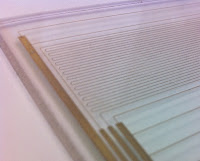It's been over a month since my last post, and even though I've printed a bunch of things I still don't understand Skeinforge very well. I managed to combine settings from a few posts on forums to get fairly reliable prints with PLA. Here's a few of the things I've made:
 |
| More octopodes |
 |
| Shuriken refrigerator magnet |
Octopodes or octopi, I like them both. But the thicker legs on the former are the way to go if you are printing with PLA.
My boys had to flight test the shuriken, hence the lack of pointy bits as you can see in the picture.
 |
| 30mm and 20mm companion cube |
The companion cubes were something I was dying to print since I say them on Thingiverse. The one on the right is my first attempt at the normal 20mm size. I believe I used a 0.25mm layer height, and it just didn't get enough of the detail that I was hoping for. Once I got more comfortable playing with settings in Skeinforge, I redid it scaled to 30mm with a 0.2mm layer height. Much better. I'll do it again when I get some nice gray ABS.
I decided to find something bigger on Thingiverse. I really like the way
MakeALot's Bracelet V came out. Even though it's a very periodic, mathematical design, it still has a somewhat organic look.
 |
| Bracelet V |
 |
| Invader Number 3 |
I also decided to try some earrings, and I'm not up to the caliber of what
Schorhr can do, so I got the
space invader things, scaled down invader number 3, printed it and drilled a hole in the hand (tentacle?) for the hardware. Big hit at the sci-fi get together my family went to.
 |
| New Z-axis Coupling |
So enough of the toys already. I really wanted to make something useful. One of the problems that showed up early was that my Delrin z-axis couplers were apparently not as straight as I had hoped they would be. So I ended up with a bit of a wave in the vertical plane on all my prints. First I tried to fix it using the plastic tubing and threaded coupler method, but I couldn't get the coupler to hang on to the tubing. So then I tried
nophead's Z coupling that still uses the tubing, but clamps the joint very nicely. It worked beautifully. My subsequent prints (including the 30mm companion cube) have been very straight.
 |
| Filament Spool and Mount |
The next useful thing I wanted to do was to make something to hold the filament. Until now I've just been sort of draping around one of the Z motors. Problem is, I have to then baby-sit the printer to make sure the filament doesn't get caught up on anything.
 |
| Redesigned Part of Spool Mount |
I really liked the design of
randyy's filament spool but I needed to find a way to mount it to my printer since the spool mount was designed for a Makerbot printer. As usual, I was not the first person to want to do this, and
reprapperMC had already figured out a solution I was happy with. Unfortunately, I didn't have enough threaded rod on the end of the Z motor mounts to fit this particular spool mount. So I took my first real foray into OpenSCAD and redesigned the necessary part to be thinner at the bottom, and to clear the smooth Z rod clamp. I also wanted to be able to easily swap out the spool in order to change colors or materials. So I made a block for the top of the mount rod that could recieve the hub that was originally designed to fit the laser-cut wood on the Makerbot machines. Took me a couple of tries to print right due to small size and ambient heat wave, but it works very well.
 |
| Block to Receive Spool Hub |
 |
| Original Spool Hub and New Block |
My RepRap is now a self improving machine. My next big step is to make a heated bed. Fortunately, I work for a
company that specializes in adding resistors and circuits to pretty much any type of object, so creating a heater and thermistor on a piece of glass will be a walk in the park. The mechanical part of adding it to the machine will be much more difficult for me.





















